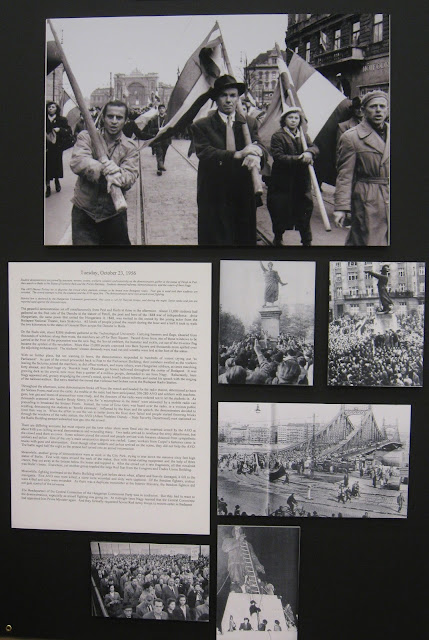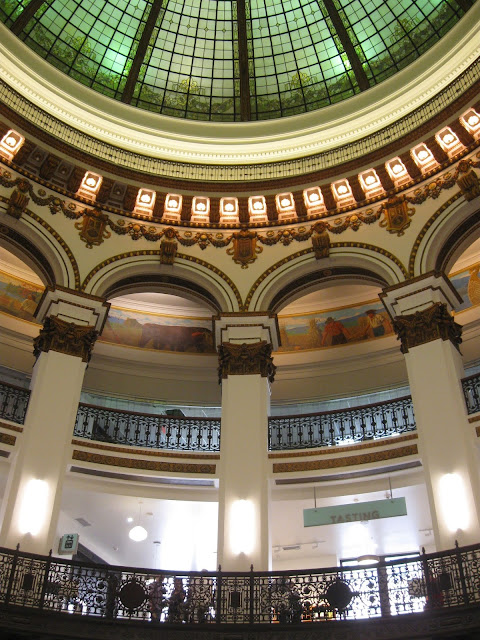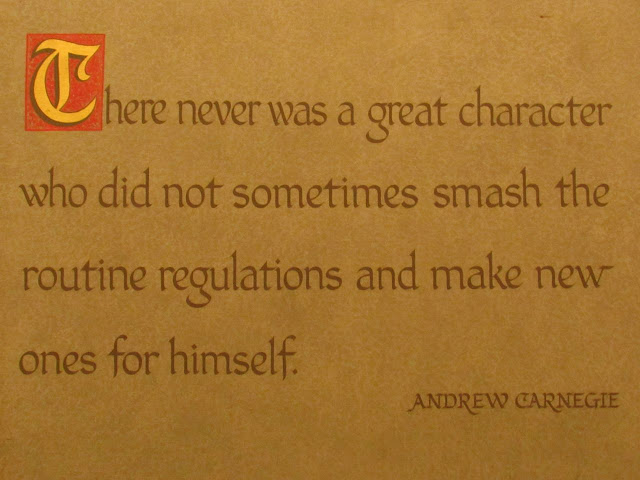. . . looking pretty darned good, actually.
The
Society of American Archivists (SAA) is meeting in Cleveland, Ohio this year, and I've been pleased and surprised by the changes that have come to the city's downtown in recent years. I grew up roughly twenty miles east of Cleveland, and I have vivid memories of the city's bad old days. Things have changed. Downtown is full of new restaurants, hotels, shops, and the sights and sounds of construction are everywhere.
 |
| Cathedral of St. John the Evangelist, East 9th Street and Superior Avenue, Cleveland, Ohio, 2015-08-18. |
SAA is meeting in the Cleveland Convention Center, and attendees are scattered throughout a number of downtown hotels. Judging from my Facebook feed, many of my friends are staying in upper floor rooms that have panoramic views of the city skyline. I'm staying in a lower floor room that faces away from the downtown core, but the
Cathedral of St. John the Evangelist, which was built in 1848-1852 and extensively reconstructed in 1946-1948, is directly across the street from my window. I've already gotten used to hearing its bells chime every quarter hour.
 |
| John Morrell, "Life Is Sharing the Same Park Bench," East 9th Street and Rockwell Avenue, Cleveland, Ohio, 2015-08-19. |
Just down the street from my hotel is an appealing wall mural that I at first found both appealing and oddly familiar: "Life Is Sharing the Same Park Bench." A quick Web search revealed that it was painted by Rochester, New York artist John Morrell and that the Association for the Advancement of Social Work with Groups made this image its logo at some point in the 1970s.
This morning, I walked down East 9th Street to the Galleria at Riverview; given that no river can be seen from this building, the name is a bit odd. The Galleria was a shopping mall that opened to great fanfare in 1987, but it rather quickly fell on hard times. Cleveland was a lot rougher around the edges in the 1980s and the 1990s, the Galleria itself is located on the outer edge of downtown's core, and the facility didn't get the foot traffic needed to sustain the relatively high-end shops that were its first tenants. The Galleria is currently home to several popular restaurants and a large YMCA branch is slated to open in a few months, but quite a few of its storefronts are still vacant.
 |
| Cleveland Hungarian Museum, Galleria at Riverview, East 9th Street and St. Clair Avenue, Cleveland, Ohio, 2015-08-19. |
I didn't go to the Galleria to ponder real estate development gone wrong but to visit one of its newer tenants: the
Cleveland Hungarian Museum. The Cleveland area has long had a large and vibrant Hungarian community, and there was talk of creating a museum that focused on the community's history well before I moved away. When I discovered that the museum was located two blocks away from my hotel, I figured I should check it out.
 |
| Folk embroidery, Cleveland Hungarian Museum, Galleria at Riverview, East 9th Street and St. Clair Avenue, Cleveland, Ohio, 2015-08-19. |
The museum, which is quite small, features two permanent exhibits. One traces the rise of Hungarian immigrant communities in Cleveland and the United States and profiles prominent Hungarian-Americans. The other focuses on Hungarian and Hungarian-American folk art.
 |
| Panel from "End of the Cold War: The Fall of Communism in Hungary and Eastern Europe" exhibit, Cleveland Hungarian Museum, Galleria at Erieview, East 9th Street and St. Clair Avenue, Cleveland, Ohio, 2015-08-19. |
The museum also has a temporary exhibit space, and the exhibit currently installed in this space concerns the end of communism in Hungary and Eastern Europe. The panel above depicts events that took place during the Hungarian Revolution in 1956. After the Soviet Union reasserted control, a substantial number of Hungarians managed to make their way to Cleveland. (My father ultimately hired one of them. He was looking to expand his engineering team, and he figured -- correctly, as it turned out -- that anyone who possessed such formidable technical knowledge
and responded to the question, "Why did you leave your most recent position?" by saying, "Russian tanks," and leaving it at that would make a good addition to his work group.)
Three very kind, very helpful volunteers were staffing the museum at the time of my visit. They answered all of my questions with cheer and grace, and they had some interesting questions for me. (What brought me to the museum? Where did I live when I lived in the area? What precisely is the difference between a librarian and an archivist? What does "born digital" mean?) In the course of our conversation, I discovered that we used to live a couple of blocks away from one of the volunteers.
 |
| Cleveland Trust Rotunda, East 9th Street and Euclid Avenue, Cleveland, Ohio, 2015-08-19. To the right, you can see the lower floors of the 9 Cleveland (formerly known as the Ameritrust Tower and as the Cleveland Trust Tower). This Brutalist skyscraper, which was completed in 1971, was the only high-rise building designed by Marcel Breuer and Hamilton Smith |
After I left the museum, I headed south on East 9th Street with the intent of exploring another quirky treasure: the Cleveland Trust Rotunda at East 9th and Euclid Avenue. This building, which was completed in 1908 and sat vacant from 1996-2014, is now home to a supermarket operated by Heinen's, a local grocery chain.
 |
| Interior of the Cleveland Trust Rotunda, East 9th Street and Euclid Avenue, Cleveland, Ohio, 2015-08-19. |
Heinen's has done an amazing job of preserving the building's historic character.
 |
| Dome of the Cleveland Trust Rotunda, East 9th Street and Euclid Avenue, Cleveland, Ohio, 2015-08-19. |
If this isn't the most beautiful supermarket in North America, it's certainly among the top ten.
 |
| View from the corner of East 9th Street and Euclid Avenue, Cleveland, Ohio, 2015-08-19. |
Every city is a mix of the old and the new, but I kept finding all manner of interesting juxtapositions today. After I left the Cleveland Trust Rotunda and crossed Euclid Avenue, I turned and looked westward and realized that I could see the tower of Terminal Tower, which was the tallest building in the city of Cleveland -- and the state of Ohio -- until 1991, a hodgepodge of early and late 20th century architecture, and part of
Triple L Excentric Gyratory III (1980), a kinetic sculpture by George Rickey.
 |
| Cleveland Convention Center, Lakeside Avenue, Cleveland, Ohio, 2015-08-15 |
I found another interesting melding of past and present as I made my way into the Cleveland Convention Center for meetings this afternoon. The Convention Center, which was completed in 2013, is almost completely underground, and I don't know whether the mirrored pillars that anchor the eastern corner of the entry way are decorative or encase some sort of functional component of the building. I do know that they frame the Key Bank Tower -- the structure that replaced Terminal Tower as the city and state's tallest building -- and another new building while capturing the reflected image of the Cleveland's Beaux-Arts City Hall.


























